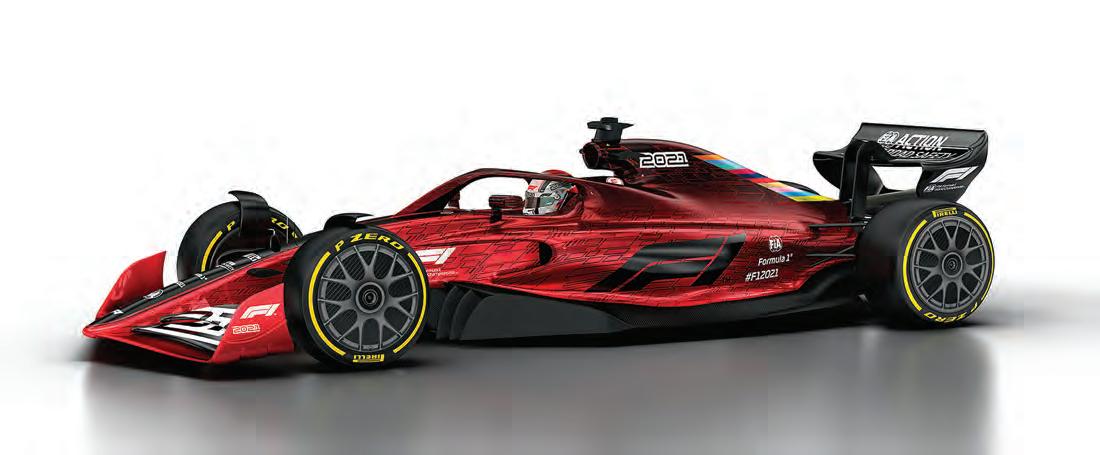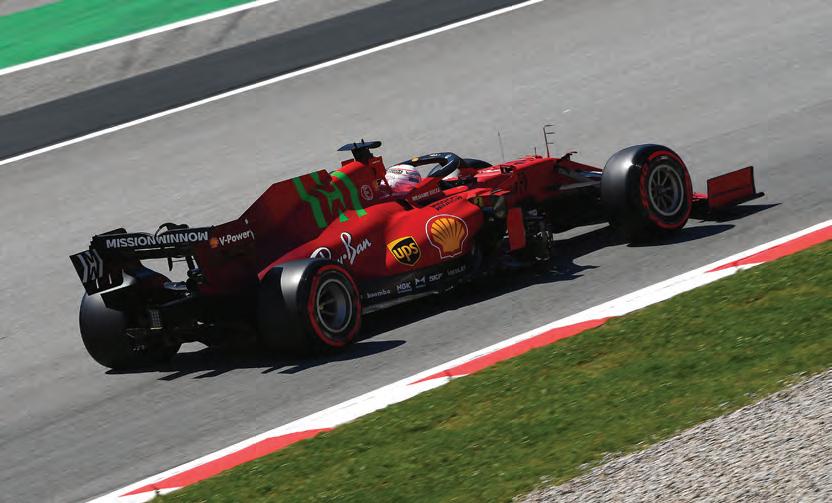
5 minute read
Formula 1
FORMULA 1 BALANCING ACT
NEW-FOR-2022 RULES MAKE FOR DIFFICULT DECISIONS IN FORMULA 1
STORY BY JEFF PAPPONE I PHOTOS COURTESY OF FORMULA 1 AND FERRARI
s Formula 1 teams fight on track for wins, points, and ultimately two world championships, a behind the scenes balancing act continues to play a key role in deciding this year’s outcome and possibly next year’s, too.
With the 2022 rules bringing wholesale changes to the cars, Formula 1 teams need to find the best mix of staying competitive this year, keeping one eye on the next, and choosing the right moment to shift all their focus to their new design.
No matter what they do, almost every choice becomes a pay me now or pay me later quandary.
“Clearly, you’re going to compromise something by going one route or the other, so I think you just have to be pragmatic,” said McLaren Racing’s technical director James Key. “What we can see is the 2022 car is such a different thing and there’s so much work to understand fully what these cars are going to be like that naturally there has to be an ongoing project in the background there somewhere, so it’s never a case of one or the other.”
For some, the pragmatic choice is an easy one. Even before this season started, Haas F1 Team boss Günther Steiner said his outfit wouldn’t “do anything with the 2021 car” and “go full throttle on” 2022. That may sound like an easy decision for a team battling not to be last this year, but it still has consequences.
Williams Racing driver, and Canadian, Nicholas Latifi pointed out that even gaining one spot in the final standings means a difference of millions of dollars in prize money that could ease other pressures on the team in 2022.
“It’s definitely a question that every team is weighing and trying to decide when is the right moment to really just abandon ship on development regardless of the position of the car?” said the Canadian.
Further up the grid, those decisions get more intricate. With Lewis Hamilton locking horns with Red Bull Racing’s Max Verstappen on every weekend, the Mercedes AMG F1 Team knows that a move to forgo more speed this year could come at the cost of world championship glory.
“You could spend all night staring at the ceiling over that instead of sleeping, but you can comfort yourself by knowing that at least the people you’re competing with have got the same dilemma,” said Mercedes chief technical officer James Allison.
“Over the years, teams that face the same sort of dilemma make similar judgments. They tend to do a little bit more on the current car than they ought to, just because the bird in the hand feels a little more valuable than the one in the bush, but no one – unless they’re pretty stupid – ignores what’s coming down the tracks.”
If that already didn’t create enough complexity, regulation changes for 2021 added even more to the mix by stripping relatively more performance from cars with a low rear ride height like the Mercedes than high-rake style entries such as the Red Bull.
While Mercedes’ work in the first few weeks of the season moved


(Above and opposite page) The new Formula 1 aero rules will make the cars look significantly different from their pre2022 counterparts. (Right) Ferrari, with nothing to lose in 2021, is a sleeping giant who can focus on the 2022 season exclusively this year.
it closer to Red Bull, it also demonstrated the pressure teams face as they try to balance short- and long-term goals.
“There simply isn’t a solution: You can’t do everything this year and everything next year; you can only split your resources in a way that feels like you are being as brave as you dare to be,” said Allison.
The final piece of the puzzle relates to the wind tunnel and computational fluid dynamics time allotted to the teams, which is now done on a sliding scale based on the previous year’s results. The last place team gets about 20 percent more time than first.
Although the floor changes also hit Aston Martin hard and it went from fourth overall in constructors last year to struggling to score points in 2021, trying to close the gap likely isn’t in the cards.
“We have a limited amount of time and using it to regain the lost downforce for this year comes at the cost of not doing experiments for next year,” said Aston Martin team boss Otmar Szafnauer.
Although it hasn’t shifted to 2022 yet, Szafnauer indicated that it would likely happen sometime in early June.
And that’s what really keeps Allison up at night: teams making huge strides on their 2022 car, while his outfit must continue to make trade-offs to stay on top of its ongoing title battles.
“The people who are scary or potentially scarier are the ones that have absolutely nothing to gain or lose this year,” said Allison,
“A team like Ferrari, let’s say, is well-resourced, absolutely not in the fight this year and, as it happens, boosted considerably in their aerodynamic resource by the handicapping system and their dreadful results from the year before – they don’t have the same type of dilemma that we have, and they could go far more all-in on next year and just accept whatever mess occurs this year.”
While who will do what and when remains anybody’s guess, one thing is certain: teams need to get it right in 2021 or they’ll put themselves on the wrong foot this year, and potentially stay there in 2022.
And, as the saying goes, timing is everything in racing.
“Deadlines will come quickly,” said Key. “As soon as we’re over the August break that’s when your definition period really begins to kick in and you’ve got to finalize the architecture and the direction you want to take on certain major parts of the car. I think in those months, the balancing act is going to be the key thing.” IT







